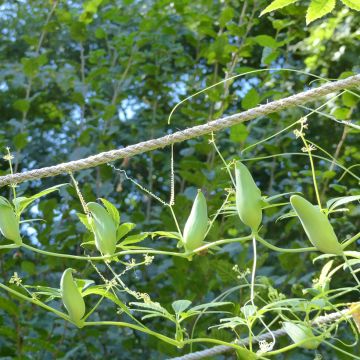

Graines de Viola cornuta Sorbet Peach Melba F1 Hybrid - Violette cornue
Viola cornuta Sorbet Peach Melba F1 Hybrid - Horned pansy
Viola cornuta Sorbet Peach Melba F1 Hybrid
Horned pansy
This plant carries a 6 months recovery warranty
More information
We guarantee the quality of our plants for a full growing cycle, and will replace at our expense any plant that fails to recover under normal climatic and planting conditions.
Seed-only orders are dispatched by sealed envelope. The delivery charge for seed-only orders is €3.90.
Does this plant fit my garden?
Set up your Plantfit profile →
Description
Viola cornuta 'Sorbet Peach Melba' F1 Hybrid, also known as the hybrid horned violet, produces compact plants that form small clumps covered with an abundance of small flowers in stunning colours, in a mixture of pink and yellow, speckled with reddish-brown. This biennial plant is easy to grow, tolerates heat and is cold-resistant, and blooms for a very long period. It will bring a cheerful and refined touch to borders, balconies, or terraces. It should be grown in humus-rich and moist soil, in full sun or partial shade.
Belonging to the violet family, the horned violet, which grows spontaneously in the Pyrenees, is a low perennial plant that has given rise to numerous hybrids and cultivars. Often crossed with Viola tricolor (wild pansy), their most famous descendants are the horticultural pansies. The 'Sorbet Peach Melba' F1 Hybrid variety, from which it originates, is a herbaceous spreading plant that reaches a height of 15cm (6in) in flower, with dark green, ovate, and serrated evergreen leaves, forming a spreading tufted habit. Depending on the sowing date, this plant is covered in flowers from spring to autumn. Its compound flowers with 5 petals resemble those of small pansies, but their petals are arranged differently. The top two petals are upright, pale yellow tinged with old rose, while the other three are downward-facing, in a bright yellow colour with a reddish-brown spot centered towards the petal edge. The base of these three petals is adorned with red 'whiskers'. The plant spreads quite rapidly thanks to its rhizomes and also self-seeds very easily in the garden, not always true to type.
Horned violets are intended for the flowering of low beds, borders, but also pots and balconies, where they will be associated with other spring and summer flowering plants. (Forget-me-nots, Dwarf Narcissus, Daisies, Primroses, Botanical Tulips, summer and autumn asters, etc.). The flowers of horned violets are edible, so do not hesitate to decorate your plates with one or two flowers, or even to add a few to your salads to give them a touch of colour.
Report an error about the product description
Flowering
Foliage
Plant habit
Botanical data
Viola
cornuta
Sorbet Peach Melba F1 Hybrid
Violaceae
Horned pansy
Cultivar or hybrid
Other Thompson and Morgan seeds
Planting and care
Sow horned violet in a nursery from July to September, then transplant the young plants into buckets. Plant your young plants in October before the first frost, spacing them 20cm (8in) apart, in open ground.
Second option: sow under cover at the end of winter and plant the seedlings in open ground at the end of spring.
Germination takes about 15 days at 16°C (60.8°F).
Use a compound mixture of 1/3 compost, 1/3 garden soil, and 1/3 river sand. It takes 15 days for the seedlings to appear. Watch out for attacks from snails and slugs, as they are fond of these young plants.
Removing faded flowers will promote flowering renewal.
Horned violets prefer a light, humus-rich, moist but well-drained soil, as they fear excessive moisture in winter. In heavy soil, add some sand to improve drainage.
Plant horned violets in a sunny but not scorching location or under light shade.
Sowing period
Intended location
This item has not been reviewed yet - be the first to leave a review about it.
Flower seeds
Haven't found what you were looking for?
Hardiness is the lowest winter temperature a plant can endure without suffering serious damage or even dying. However, hardiness is affected by location (a sheltered area, such as a patio), protection (winter cover) and soil type (hardiness is improved by well-drained soil).

Photo Sharing Terms & Conditions
In order to encourage gardeners to interact and share their experiences, Promesse de fleurs offers various media enabling content to be uploaded onto its Site - in particular via the ‘Photo sharing’ module.
The User agrees to refrain from:
- Posting any content that is illegal, prejudicial, insulting, racist, inciteful to hatred, revisionist, contrary to public decency, that infringes on privacy or on the privacy rights of third parties, in particular the publicity rights of persons and goods, intellectual property rights, or the right to privacy.
- Submitting content on behalf of a third party;
- Impersonate the identity of a third party and/or publish any personal information about a third party;
In general, the User undertakes to refrain from any unethical behaviour.
All Content (in particular text, comments, files, images, photos, videos, creative works, etc.), which may be subject to property or intellectual property rights, image or other private rights, shall remain the property of the User, subject to the limited rights granted by the terms of the licence granted by Promesse de fleurs as stated below. Users are at liberty to publish or not to publish such Content on the Site, notably via the ‘Photo Sharing’ facility, and accept that this Content shall be made public and freely accessible, notably on the Internet.
Users further acknowledge, undertake to have ,and guarantee that they hold all necessary rights and permissions to publish such material on the Site, in particular with regard to the legislation in force pertaining to any privacy, property, intellectual property, image, or contractual rights, or rights of any other nature. By publishing such Content on the Site, Users acknowledge accepting full liability as publishers of the Content within the meaning of the law, and grant Promesse de fleurs, free of charge, an inclusive, worldwide licence for the said Content for the entire duration of its publication, including all reproduction, representation, up/downloading, displaying, performing, transmission, and storage rights.
Users also grant permission for their name to be linked to the Content and accept that this link may not always be made available.
By engaging in posting material, Users consent to their Content becoming automatically accessible on the Internet, in particular on other sites and/or blogs and/or web pages of the Promesse de fleurs site, including in particular social pages and the Promesse de fleurs catalogue.
Users may secure the removal of entrusted content free of charge by issuing a simple request via our contact form.
The flowering period indicated on our website applies to countries and regions located in USDA zone 8 (France, the United Kingdom, Ireland, the Netherlands, etc.)
It will vary according to where you live:
- In zones 9 to 10 (Italy, Spain, Greece, etc.), flowering will occur about 2 to 4 weeks earlier.
- In zones 6 to 7 (Germany, Poland, Slovenia, and lower mountainous regions), flowering will be delayed by 2 to 3 weeks.
- In zone 5 (Central Europe, Scandinavia), blooming will be delayed by 3 to 5 weeks.
In temperate climates, pruning of spring-flowering shrubs (forsythia, spireas, etc.) should be done just after flowering.
Pruning of summer-flowering shrubs (Indian Lilac, Perovskia, etc.) can be done in winter or spring.
In cold regions as well as with frost-sensitive plants, avoid pruning too early when severe frosts may still occur.
The planting period indicated on our website applies to countries and regions located in USDA zone 8 (France, United Kingdom, Ireland, Netherlands).
It will vary according to where you live:
- In Mediterranean zones (Marseille, Madrid, Milan, etc.), autumn and winter are the best planting periods.
- In continental zones (Strasbourg, Munich, Vienna, etc.), delay planting by 2 to 3 weeks in spring and bring it forward by 2 to 4 weeks in autumn.
- In mountainous regions (the Alps, Pyrenees, Carpathians, etc.), it is best to plant in late spring (May-June) or late summer (August-September).
The harvesting period indicated on our website applies to countries and regions in USDA zone 8 (France, England, Ireland, the Netherlands).
In colder areas (Scandinavia, Poland, Austria...) fruit and vegetable harvests are likely to be delayed by 3-4 weeks.
In warmer areas (Italy, Spain, Greece, etc.), harvesting will probably take place earlier, depending on weather conditions.
The sowing periods indicated on our website apply to countries and regions within USDA Zone 8 (France, UK, Ireland, Netherlands).
In colder areas (Scandinavia, Poland, Austria...), delay any outdoor sowing by 3-4 weeks, or sow under glass.
In warmer climes (Italy, Spain, Greece, etc.), bring outdoor sowing forward by a few weeks.
























































